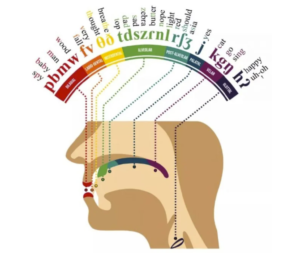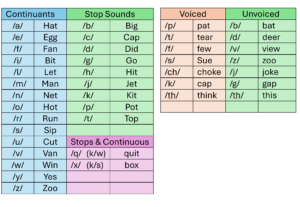
Correct Pronunciation of Phonemes is Critical…Why?
“Awareness of articulatory gestures facilitates the activation of graphophonemic connections that helps children identify written words and secure them in memory.” (Ehri)
As you have learnt, beginning readers acquire letter sound knowledge by matching their visual memory of letters with their phonological memory (sound). All beginning readers need to know how to produce speech sounds (phonemes) in isolation, and how to pronounce these phonemes correctly. When teaching and modelling the sounds of language (phonemes), it is critically important that teachers articulate the phonemes of speech accurately.
A common mistake that teachers make is distorting the phoneme by adding a “schwa…uh”, sound to unvoiced consonants e.g. PUH for /p/, TUH for /t/, and even SUH for /s/ (a continuant phoneme). Teachers often do this without realising, it can originate from a regional accent /habit, and it can be a byproduct of how they learnt to articulate sounds. When an additional sound is added to the pure sound, this makes it difficult to synthesise (blend) individual sounds when decoding. This is also reflected when students are encoding (spelling) words. E.g. cat (3 phonemes /c/ /a/ /t/) = catuh (/c/ /a/ /t/ + /u/ = 4 phonemes).
Teachers need to be aware of how sounds are made and articulated. An awareness of stop sounds, continuants, voiced and unvoiced sounds will help teachers navigate how to teach, guide and support speech sound development. Explicitly teaching voiced and unvoiced phonemes help to facilitate reading and spelling acquisition. Your school speech pathologist can guide you in the right direction if you wish to learn more.

Stop sounds – These are phonemes that are said for a very brief time. The airflow is stopped completely for a short time. These are more difficult for children to hear than continuant sounds.
Continuants – These are phonemes that can be held for several seconds without distortion.
Voiced and unvoiced consonant sounds. https://youtu.be/495LciokKag?si=obxnGGJob1i2aHsk
Implications for English Language Learners
Things to consider when you are working with English language Learners:
- Phonemic awareness skills travel across languages,
- Word reading develops similarly to native speakers however there is a brief time lag, which is dependent upon age, previous reading acquisition, similarities across languages.
- Comprehension lag of up to 5 -6 years due to language development (Kilpatrick, 2019).
Reading Development and Difficulties: Bridging the Gap Between Research and Practice | SpringerLink
English language learners exhibit three main difficulties:
- Substitution – students will substitute sounds not present in their first language with the closest equivalent from their 1st
- Discrimination – students may have difficulty hearing, detecting and distinguishing between sounds in their new language,
- Pronunciation – students may have difficulty pronouncing new sounds because of unfamiliar tongue position and mouth position required in their new language (Berry & Hudson, 1987).
- Students will require explicit instruction of sound articulation.
Suggestions of how to support English Language Learners (ELL) in your classroom:
- Small group instruction to build vocabulary. ELL students can be introduced to new words that they will be working with the following day,
- Practice sound articulation and mouth position,
- Provide extra opportunity to practice.
Links to supporting resources
- Cued Articulation (Jane Passy) Sounds for Literacy – cued articulation
- https://youtu.be/BPLnfNciLbA Video of hand gestures and sounds
- Reading Development and Difficulties: Bridging the Gap Between Research and Practice | SpringerLink
Helpful Resources & Further Links to Learning
Speech pathologist Alison Clarke from Spelfabet has made this series of videos demonstrating voiced and unvoiced phonemes and more. » Phonemes are sounds AND articulatory gestures (Spelfabet)
Sounds for Literacy – research (Cued Articulation)
Teaching grapheme-phoneme correspondences – Five from Five
